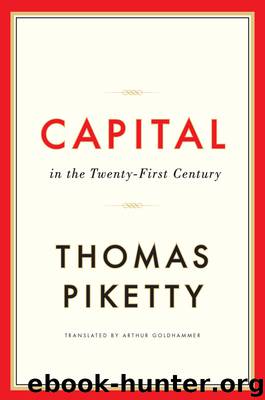Capital in the Twenty-First Century by Thomas Piketty

Author:Thomas Piketty [Piketty, Thomas]
Language: eng
Format: epub, mobi, azw3
Publisher: The Belknap Press of Harvard University Press
Some Partial Explanations: Time, Taxes, and Growth
In the end, then, it is hardly surprising that the concentration of wealth decreased sharply everywhere between 1910 and 1950. In other words, the descending portion of Figures 10.1–5 is not the most difficult part to explain. The more surprising part at first glance, and in a way the more interesting part, is that the concentration of wealth never recovered from the shocks I have been discussing.
To be sure, it is important to recognize that capital accumulation is a long-term process extending over several generations. The concentration of wealth in Europe during the Belle Époque was the result of a cumulative process over many decades or even centuries. It was not until 2000–2010 that total private wealth (in both real estate and financial assets), expressed in years of national income, regained roughly the level it had attained on the eve of World War I. This restoration of the capital/income ratio in the rich countries is in all probability a process that is still ongoing.
It is not very realistic to think that the violent shocks of 1914–1945 could have been erased in ten or twenty years, thereby restoring by 1950–1960 a concentration of wealth equal to that seen in 1900–1910. Note, too, that inequality of wealth began to rise again in 1970–1980. It is therefore possible that a catch-up process is still under way today, a process even slower than the revival of the capital/income ratio, and that the concentration of wealth will soon return to past heights.
In other words, the reason why wealth today is not as unequally distributed as in the past is simply that not enough time has passed since 1945. This is no doubt part of the explanation, but by itself it is not enough. When we look at the top decile’s share of wealth and even more at the top centile’s (which was 60–70 percent across Europe in 1910 and only 20–30 percent in 2010), it seems clear that the shocks of 1914–1945 caused a structural change that is preventing wealth from becoming quite as concentrated as it was previously. The point is not simply quantitative—far from it. In the next chapter, we will see that when we look again at the question raised by Vautrin’s lecture on the different standards of living that can be attained by inheritance and labor, the difference between a 60–70 percent share for the top centile and a 20–30 percent share is relatively simple. In the first case, the top centile of the income hierarchy is very clearly dominated by top capital incomes: this is the society of rentiers familiar to nineteenth-century novelists. In the second case, top earned incomes (for a given distribution) roughly balance top capital incomes (we are now in a society of managers, or at any rate a more balanced society). Similarly, the emergence of a “patrimonial middle class” owning between a quarter and a third of national wealth rather than a tenth or a twentieth (scarcely more than the poorest half of society) represents a major social transformation.
Download
Capital in the Twenty-First Century by Thomas Piketty.mobi
Capital in the Twenty-First Century by Thomas Piketty.azw3
This site does not store any files on its server. We only index and link to content provided by other sites. Please contact the content providers to delete copyright contents if any and email us, we'll remove relevant links or contents immediately.
The Secret History by Donna Tartt(16627)
The Social Justice Warrior Handbook by Lisa De Pasquale(11489)
Thirteen Reasons Why by Jay Asher(7788)
This Is How You Lose Her by Junot Diaz(5774)
Weapons of Math Destruction by Cathy O'Neil(5038)
Zero to One by Peter Thiel(4824)
The Myth of the Strong Leader by Archie Brown(4789)
Promise Me, Dad by Joe Biden(4449)
Beartown by Fredrik Backman(4419)
Stone's Rules by Roger Stone(4416)
How Democracies Die by Steven Levitsky & Daniel Ziblatt(4399)
The Fire Next Time by James Baldwin(4343)
100 Deadly Skills by Clint Emerson(4079)
A Higher Loyalty: Truth, Lies, and Leadership by James Comey(4033)
Rise and Kill First by Ronen Bergman(4012)
The David Icke Guide to the Global Conspiracy (and how to end it) by David Icke(3883)
The Farm by Tom Rob Smith(3872)
Secrecy World by Jake Bernstein(3783)
The Doomsday Machine by Daniel Ellsberg(3731)
